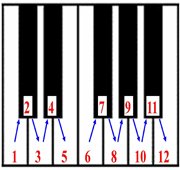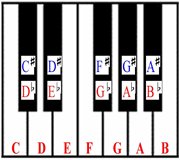Playing Major Scales
on the Piano
Major scales are among the first set of finger exercises that all beginner piano players should learn to play during the early stages of their musical development.
This type of scale refers a group of eight notes beginning and ending with same letter name. So if the scale starts with C it will end with C.
For example: C, D, E, F, G, A, B, C.
Each note is played one after the other until you reach the 8th note. Some sources define a scale as a succession of eight notes.
A major scale sounds like this: DOH RAY ME FA SO LA TE DOH.
This basic melody is known as one type of solfa notation that is used in music especially singing.
Do you notice that it begins with a DOH and ends with a DOH? However, the first DOH is lower in pitch than the last DOH which is at position number eight in the scale.
This explains why a scale begins and ends with same letter name; the difference is the pitch of the notes. There are twelve keys on the piano keyboard. These twelve keys are repeated in different chunks.
So don’t be confused or turned off by the number of black and white keys that you see when you approach the piano.
The illustrations below will show you the layout of the 12 keys on the keyboard.


PLEASE NOTE – It is very important that you know the letter names of all the keys on the keyboard before you approached the concept of scales.
Click here to learn the letters of the piano keys in minutes.
So you know that there are 12 keys that exist on the piano, this means that there are only twelve major scales to be learned. However, there are specific formulas that are used when constructing these type of scales.
C major is the easiest scale to be played on the piano; this is because C major has no sharp or flat.
Below is an illustration showing the letters of the C scale and the fingering technique for both the right and left hand.


The thump is referred to as the 1st finger and the little finger is referred to as the 5th finger. This applies to both hands.
Below are some illustrations of other major scales that are used in music. Notice the number of sharps that are placed in each scale.
The sharp sign is there to indicate that you should play the specific black key and not the white or natural key on the keyboard.
Click here to learn more about the letters of the black keys.






Please take advantage of the information. Please practice these scales at different tempo.
Learn More!
Click here to learn about minor scales!
Click here to learn about blues scales!
Click here to learn about pentatonic scales!
Click here to leave the major scales page and return to home page.
Subscribe to receive free piano lessons
E-zines and other updates!









